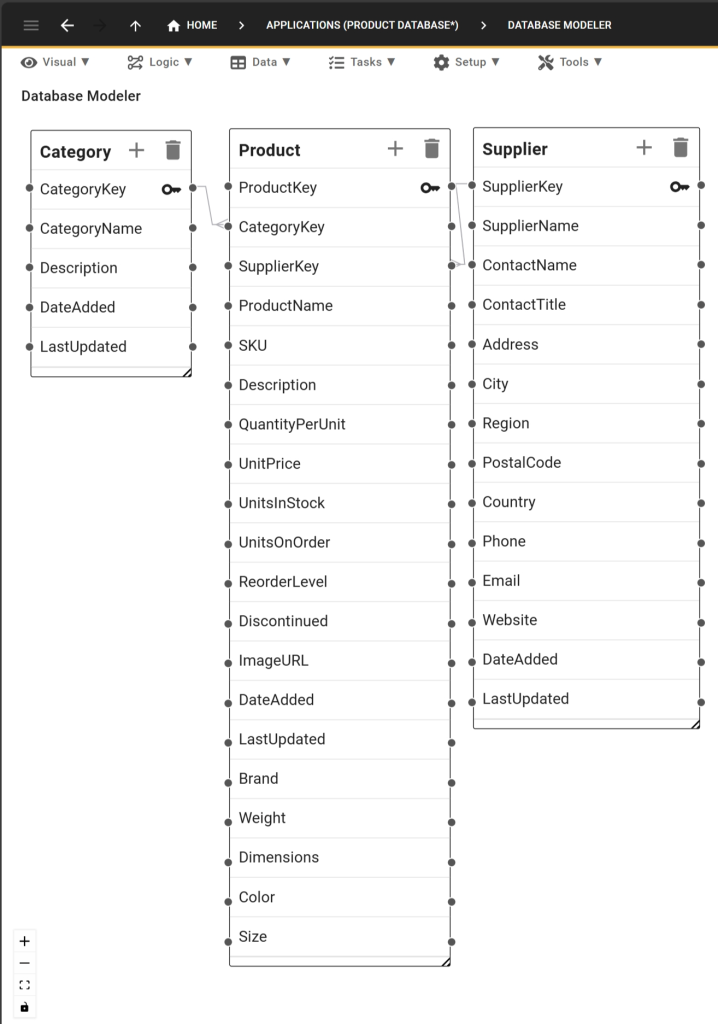Create a Supplier Database In 3 Steps
Create a Supplier Database – The Simple Way
A supplier database is essential for businesses that rely on multiple vendors to provide goods or services. A database keeps track of supplier details, contract terms, and order histories, serving as the central source of truth for managing supplier relationships. It also lets you compare suppliers and keep track of their performance and prices, enabling you to make better decisions about whom to select as a supplier. Some databases can also be used as supplier or vendor portals, where suppliers can log in and access purchase orders (POs) or maintain their contact details, easing the burden on internal staff to manage suppliers and related information.
If you’re unsure where to begin, this guide will walk you through creating an efficient supplier database, helping you avoid issues like missed orders and unreliable supplier tracking. Even better, it introduces you to a ready-to-use supplier database application that gives you all the essential features for better supplier management.
Let’s dive in and learn how to develop a supplier database.
Explore Our Intuitive Supplier Database
Our fully featured, scalable Supplier Database Portal lets you manage supplier data, payments, contracts and vendors intuitively and in one place.
Why Build a Supplier Database?
A good supplier database is key to smooth purchasing and successful supplier/vendor management. It helps you:
✅ Keep an eye on how suppliers are doing
✅ Follow up on orders, shipments and deliveries
✅ Handle contracts
✅ Make sure orders arrive on time
Having all your supplier info in one place means everyone’s on the same page. This lets you make smarter choices about who to buy from and how to work with them.
What Is a Supplier Database?
A supplier database stores detailed information about your vendors, such as supplier names, contact details, contract terms, pricing agreements, minimum order quantities, delivery schedules, and payment terms.
It also helps businesses maintain a clear record of supplier performance, track contract renewal dates, and ensure timely reordering. With a well-structured supplier database, companies can streamline procurement processes, improve supplier relationships, and ensure compliance with agreed terms and quality standards.
Let’s say you’re in charge of buying items for a factory. Your main computer system might handle the basics, like who your suppliers are and what you’ve ordered. But it might not be great at keeping track of all the nitty-gritty details like contract specifics or supplier performance metrics.
That’s where a proper supplier database comes in handy. It’s like a one-stop shop for everything about your suppliers. You can search it easily, and it keeps all the important info in one place. This makes it much easier to keep an eye on how things are going with all your vendors.
Why Spreadsheets Fall Short for Supplier Databases
Let’s face it, many of us start out tracking our suppliers in Excel or Google Sheets. It seems easy at first, especially when you’re just starting. But as your business grows, these spreadsheets can cause some real headaches:
❌ Version Chaos
Before you know it, everyone’s got their copy. You end up with a mess of files like “SupplierList_LATEST,” “Vendor Database – Updated,” “Old Supplier List – IGNORE,” and so on. Who knows which one’s right?
❌ No Clear History
Without a proper system, it’s hard to keep track of who changed what and when. If the person in charge of updates leaves, you might be left scratching your head about why certain changes were made.
❌ Data Gets Messy
People start adding their own notes, highlighting things, and making manual tweaks. Soon enough, you’ve got a rainbow of colors and comments that don’t make sense to anyone else. For example, someone might mark a supplier in red to show they’re unreliable, but others might miss it or misunderstand.
Using spreadsheets for your supplier info goes against the whole point of having one trustworthy source of data. Instead of smoothly managing your suppliers, you end up playing detective with a bunch of conflicting spreadsheets.
Building a real supplier database with a proper tool can solve these problems. It gives you one central place for all your supplier info that everyone can rely on.
Ditch Excel For Better Data Management
Excel or spreadsheets aren’t the right solution for supplier management. What’s a better alternative?
A supplier database with an intuitive web user interface! Check out our ready-to-use supplier database application that comes with all the essential features for better supplier management.
Professionalize Your Supplier Management
Five gives you all the essential tools to build and launch a modern supplier database application:
1️⃣ A prebuilt, user-friendly supplier database application that you can implement instantly
2️⃣ The ability to customize your application by adding dashboards, notifications, reports, user roles, etc.
3️⃣ A fully flexible database that can be tailored to your business and its requirements.
How to Create a Supplier Database in 3 Steps
If you’re running a business, you probably don’t have time to become a database expert. Normally, to develop an application from scratch, you’d need to fully understand concepts like SQL and how to build user interfaces. That’s a lot to ask when you’re busy keeping your business running.
This is why many small businesses put off creating a proper supplier database. It just seems too complicated and time-consuming. But here’s where Five comes in handy. We have created a library of ready-to-use database applications, including a secure and user-friendly supplier database, that are fully customizable.
With Five, you can:
✅ Quickly set up a supplier database in a user-friendly interface without any extra work.
✅ It’s easy to import your existing supplier data from Excel or other spreadsheets, so you don’t have to start from scratch.
✅ You can also add custom features like detailed reports about your suppliers and set up charts to help you visualize your data at a glance.
✅ One of the handiest features is the ability to set up alerts that let you know when it’s time to reorder from a supplier, helping you stay on top of your inventory needs.
✅ Plus, apps developed in Five work on any device. So, whether you’re at your desk or on the go, you can always check your supplier info.
Want to give it a shot? Here’s how to get started:
1️⃣ Visit our supplier database application and sign up for a free preview.
2️⃣ List out and prioritize enhancements and customizations.
3️⃣ Implement your enhancements and customizations to make the supplier database truly yours.
Step 1: Access the Supplier Database
Building a supplier database from scratch is time-consuming and unnecessary when you can start with a pre-configured solution.
Our ready-to-use supplier database eliminates the heavy lifting—it comes equipped with secure authentication, intuitive dashboards for tracking supplier performance, powerful contract management, and automated workflows for expiring contracts or pending orders. You can import your existing supplier list seamlessly, bypassing weeks of development work.
Designed for immediate usability, this system helps you onboard suppliers faster, monitor critical metrics at a glance, and minimize manual data entry errors—all without writing a single line of code.
Step 2: Enhance, Customize and Expand Your Supplier Database
Every business manages its suppliers a little differently. The good news is that our prebuilt supplier database is fully customizable. If you need features, enhancements or customizations, list them out and prioritize them. For example, think about how you interact with your suppliers and what steps can be automated. Prioritize your features to have a clear game plan for their roll-out.
✅ Essential Features (Must-Have)
These are non-negotiable for daily operations:
- Supplier contact & contract management (key personnel, agreements, terms)
- Performance tracking (delivery times, quality ratings, compliance status)
- Automated alerts for expiring certifications or contracts
✅ Important Upgrades (Should-Have)
Valuable for near-term efficiency:
- Document storage for contracts, certifications, and NDAs
- Multi-tier approval workflows for onboarding new suppliers
- Spend analytics to track purchasing trends and negotiate better terms
✅ Optional Improvements (Could-Have)
Useful but not urgent:
- AI-driven risk assessment (e.g., financial stability checks)
- Supplier self-service portals for profile updates
- Integration with accounting/ERP systems
❌ Excluded Features (Won’t-Have)
Deliberately omitted to avoid bloat:
- Overly niche compliance tracking (unless critical to your industry)
- Redundant features already covered by your procurement tools
Remember, a good supplier database grows with your business. Start with the basics, and you can always add more detail as you go along.
Step 3: Enhance and Customize the Supplier Database
With your prioritized list from Step 2, you’re ready to tailor the database to your exact business requirements. Begin with the essential must-have features that will deliver immediate operational benefits.
The fastest way to get started is by using a prebuilt supplier database, so that you don’t have to reinvent the wheel and start from scratch. Once you are familiar with the database, compare your work from Steps 1 and 2 to what our database provides out of the box.
A Simple Supplier Database Schema
Last but now least, let’s take a look at a simple supplier database schema. A supplier database must, at a minimum, store information about suppliers, products and categories. Here’s how to set this up:
Product Table
At the core of the database, this table stores information about products and their attributes.
Category Table
This table helps classify products into their respective categories, making it easier to organize and retrieve items.
Supplier Table
A critical component of the schema, this table links products to their suppliers and enables us to notify suppliers when inventory levels are low.
You can expand on this data structure by adding additional fields or additional tables. For a more comprehensive supplier database, preview our supplier database application, which comes with many useful features, such as a supplier directory, invoicing and purchase orders, supplier logins, and much more.
Each table holds specific information, such as product details, reorder levels, supplier contact information, and product categories, ensuring a comprehensive and organized structure. The relationships between these tables facilitate efficient supplier management.

Supplier Database: Key Features
A Customizable Supplier Database
Using Five’s Table Wizard, we can turn the table and field definitions of our database into working software. Five gives you a user-friendly, point-and-click database design tool that non-technical users can use to rapidly create a custom database. Add as many fields as you wish to your supplier database. The database is fully customizable and runs on MySQL, one of the world’s most popular open-source database technologies.
Simple-to-Use Forms
Next, Five lets us add forms so that we can enter data into our database. Forms enable us to store or retrieve information from our database. In addition, we can create charts, dashboards, or even PDF reports, which are ideal for sharing supplier information or managing supplier performance.
Login Protected and Secure
Securing supplier chain data is paramount for organizations of all sizes. Five comes with a pre-built authentication feature that adds a login screen to your application. For example, every (registered) supplier can have a login to the application to view or edit data. You can also add multi-factor authentication for extra security.
Generate Documents
Five lets you generate documents straight from inside the application. For example, you can easily create monthly reports about supplier performance and build approval workflows for onboarding new suppliers.
Searchable and Online
The supplier database is searchable and hosted online. It can be accessed by any device and at any time.
Get Started with Five Today
To build your supplier database with Five,
✅ Access our prebuilt supplier database solution
✅ Note down enhancements and customizations. Categorize your enhancements into essential, nice-to-have, and optional features.
✅ Implement your new features to make the database work for your business.
By following the steps mentioned above, you can create robust and scalable supplier software tailored to your business needs.


